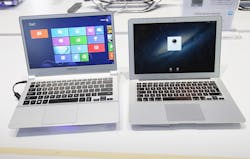Building the Internet of Things: Industrie 4.0 vs the Industrial Internet
The fast pace of innovation, technological change, and new digital applications have convinced governments and the private sector alike that this disruption needs to be enabled or catalyzed.
In The Internet of Things: Industrie 4.0 vs. the Industrial Internet, a report from the MAPI Foundation, the research affiliate of the Manufacturers Alliance for Productivity and Innovation, Director of Economic Studies Kris Bledowski compares the two.
Bledowski notes that Germany's Industrie 4.0 and the Industrial Internet Consortium (IIC) both advance the Internet of Things, and rather than competing against one another are, in fact, complementary.
"The two approaches occupy the same real estate of technology and they share some members," he said. "What unites them is the excitement about the future of the Internet of Things."
There are, though, a number of differences.
The German approach supports the country's industrial small and medium enterprises in their future adoption of cyber-physical systems while the scope of IIC research stretches beyond manufacturing to include other sectors. The German project is part of government-funded policy concerning industrial platforms of production, design, and distribution. The IIC is driven by private companies and research institutions from many countries and reaches into healthcare, transportation, distribution, and smart cities.
"Industrie 4.0 is a forward-looking vision of how the shop floor might look in 15-20 years' time," Bledowski explained. "The strength of the IIC, composed of mostly big companies, and many from the U.S. but also some from Germany, China, and India, lies in big data and cloud computing. It works on testbeds, which are experiments, and it tries different approaches to look for greater efficiency."
Bledowski notes that Industrie 4.0 strikes to optimize production while the IIC's research targets returns to any asset; Industrie 4.0 works on standardization whereas the IIC works on enabling platforms that might set future standards; and Industrie 4.0 is reactive to a fast pace of high-tech innovation while the IIC proactively pushes the frontier of any internet-based application.
"German policies attempt to preempt the possibility that the country's industry could fail to catch the digital train," he concluded. "The IIC attempts to keep the train moving forward; the consortium's members believe that a rising tide lifts all boats and they keep working together to raise that tide."
